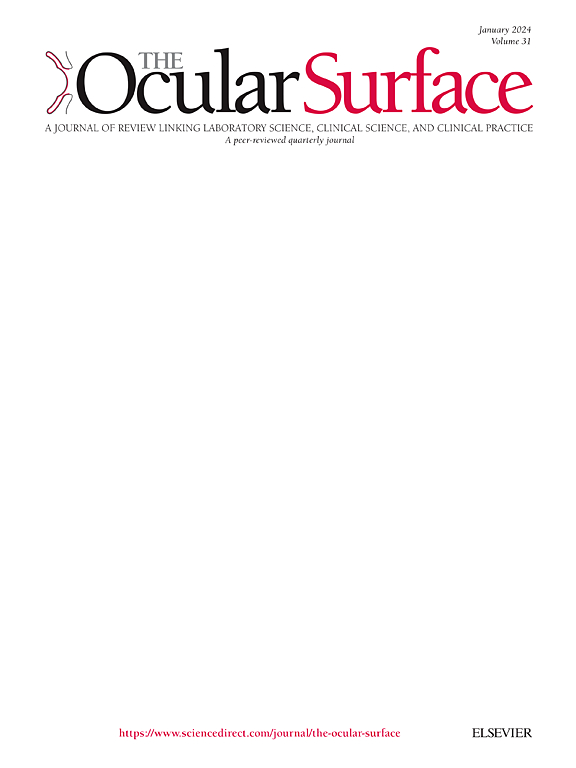Application of stem cell-derived exosomes in anterior segment eye diseases: A comprehensive update review
IF 5.6
1区 医学
Q1 OPHTHALMOLOGY
引用次数: 0
Abstract
Mesenchymal stem cell (MSC) therapy has emerged as a promising approach for addressing various eye-related conditions. Yet, its clinical application faces challenges due to issues such as limited biocompatibility and difficulties in effectively delivering treatment to specific ocular tissues. Recent studies have shifted attention towards MSC-derived exosomes, which share similar regenerative, reparative, and immunomodulatory capabilities with their origin cells. This review delves into the latest research on the use of MSC-derived exosomes for treating anterior segment diseases of the eye. It explores the exosomes' composition, biological functions, and the methods used for their isolation, as well as their roles in disease progression, diagnosis, and therapy. The review critically assesses the therapeutic advantages and mechanisms of action of MSC-derived exosomes in treating conditions like dry eye disease, Sjogren's syndrome, keratoconus, corneal lesions, and corneal allograft rejection. Additionally, it discusses the obstacles and future prospects of employing MSC-derived exosomes as innovative therapies for anterior segment eye diseases. This comprehensive overview underscores the significant potential of MSC-derived exosomes in transforming the treatment paradigm for anterior segment eye disorders, while also highlighting the necessity for further research to enhance their clinical application.

干细胞来源的外泌体在前段眼病中的应用:全面的最新综述。
间充质干细胞(MSC)治疗已成为解决各种眼部相关疾病的有前途的方法。然而,由于生物相容性有限和难以有效地将治疗递送到特定的眼部组织等问题,其临床应用面临挑战。最近的研究将注意力转移到msc衍生的外泌体上,它们与其原始细胞具有相似的再生、修复和免疫调节能力。本文综述了利用间质干细胞来源的外泌体治疗眼前段疾病的最新研究进展。它探讨了外泌体的组成、生物学功能和用于分离它们的方法,以及它们在疾病进展、诊断和治疗中的作用。这篇综述批判性地评估了间质干细胞来源的外泌体在治疗干眼病、干燥综合征、圆锥角膜、角膜病变和角膜异体排斥反应等疾病中的治疗优势和作用机制。此外,它还讨论了利用msc来源的外泌体作为前段眼病的创新疗法的障碍和未来前景。这篇全面的综述强调了msc来源的外泌体在改变前节眼疾病治疗模式方面的巨大潜力,同时也强调了进一步研究以增强其临床应用的必要性。
本文章由计算机程序翻译,如有差异,请以英文原文为准。
求助全文
约1分钟内获得全文
求助全文
来源期刊

Ocular Surface
医学-眼科学
CiteScore
11.60
自引率
14.10%
发文量
97
审稿时长
39 days
期刊介绍:
The Ocular Surface, a quarterly, a peer-reviewed journal, is an authoritative resource that integrates and interprets major findings in diverse fields related to the ocular surface, including ophthalmology, optometry, genetics, molecular biology, pharmacology, immunology, infectious disease, and epidemiology. Its critical review articles cover the most current knowledge on medical and surgical management of ocular surface pathology, new understandings of ocular surface physiology, the meaning of recent discoveries on how the ocular surface responds to injury and disease, and updates on drug and device development. The journal also publishes select original research reports and articles describing cutting-edge techniques and technology in the field.
Benefits to authors
We also provide many author benefits, such as free PDFs, a liberal copyright policy, special discounts on Elsevier publications and much more. Please click here for more information on our author services.
Please see our Guide for Authors for information on article submission. If you require any further information or help, please visit our Support Center
 求助内容:
求助内容: 应助结果提醒方式:
应助结果提醒方式:


